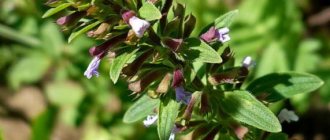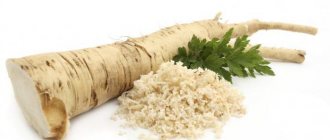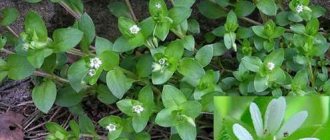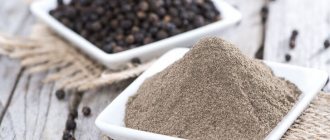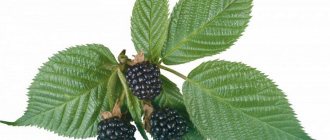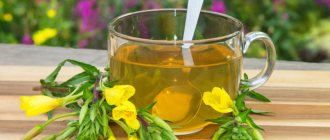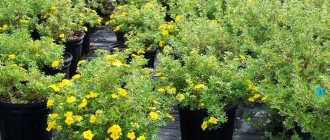Instructions for use of Alder fruits: method and dosage
A decoction and infusion prepared from the Alder fruit preparation is taken orally.
Ground vegetable raw materials
To prepare the decoction, it is recommended to place 2 tablespoons of crushed raw materials (about 10 g of fruit) in an enamel/glass container, pour 1 glass (200 ml) of chilled boiled water, cover with a lid and heat in a boiling water bath for about half an hour. Then, without cooling the product, you need to strain and squeeze out the remaining raw materials. You need to add boiled water to the prepared decoction until the volume reaches 200 ml. Should be taken 3 times a day, half an hour before meals, 2 tablespoons. The course of treatment is 20–25 days.
Raw vegetable powder
- Method 1: to prepare the infusion, it is recommended to place 1 filter bag (1.5 g) in an enamel/glass container. Fill the bag with ½ cup (100 ml) of boiling water, cover the dish with a lid and leave for half an hour, occasionally pressing on the bag with a spoon, and then squeeze out. The prepared infusion should be taken 3 times a day, half an hour before meals, ¼ cup;
- Method 2: to prepare the infusion, it is recommended to place 2 filter bags (3 g) in an enamel/glass container. Fill the bags with ½ cup (100 ml) of boiling water, cover the dish with a lid and leave for half an hour, occasionally pressing on the bags with a spoon, and then squeeze. The prepared infusion should be taken 3 times a day, half an hour before meals, 2 tablespoons.
The course of treatment is 14–21 days.
Alder cones in cosmetology
For inflammatory processes on the skin of the face, it is recommended to wash your face with an infusion of alder fruits. To prepare it, you need to chop a spoonful of cones. Pour 300 ml of boiling water. In two hours the infusion will be ready. It is filtered. Use three times a day for washing.
Alder infusion will also benefit weakened hair. Pour half a liter of boiling water into a thermos. We also place 3 tablespoons of fruits there. We insist for three hours. Rub the resulting infusion into the scalp at night every day for 10 days. After washing your hair, rinse your hair with the same infusion.
Chemical composition and application
Alder bark and cones contain up to 2.5% tannins - tannins with a pronounced astringent effect. Among other important compounds formed by its cells, mention should be made:
- triterpene alcohols and ketones, which determine the smell of the plant;
- flavonoids that have a beneficial effect on the circulatory system;
- phytoncides – substances with bactericidal properties;
- glycosides with high biological activity;
- antioxidant quercetin;
- organic acids.
Alder preparations are a centuries-old folk remedy for inflammatory diseases of the digestive tract. In the 40s of the last century, they were introduced into scientific medicine and began to be used as an adjunct to the use of sulfonamides. Infusions of alder cones and decoctions of its bark are prescribed for:
- dysbacteriosis;
- enterocolitis;
- flatulence and pain in the intestines;
- dysenteries of various etiologies;
- exacerbations of chronic intestinal infections.
Externally, a decoction of cones is used for thermal burns, inflammatory skin diseases, as well as bacterial and viral lesions of the upper respiratory tract. The use of a decoction of the leaves in the form of baths is indicated for dermatitis of the feet and tired legs. Traditional medicine offers an infusion of alder fruits as a remedy that relieves irritation of the scalp and reduces greasiness in the hair.
Soft, pure alder charcoal is valued as a painting material and as a raw material for making hunting gunpowder. The wood from this tree is used in the production of electric guitars, and the sawdust gives meat and fish a wonderful smoky smell. Alder imparts a rich black-blue color to leather when its decoction is mixed with a solution of iron-ammonium alum.
Alder preparations are a proven remedy for inflammatory diseases of the digestive tract
Alder - recipes
A decoction of leaves, bark and fruit is used as a lotion for weeping eczema, and also as a bactericidal, anti-inflammatory and astringent in the treatment of allergic dermatitis. And fresh leaves are applied to sore spots for childhood eczema, exudative diathesis, small abscesses. But the most useful thing that alder has is its cones. They are formed only in female plants from alder catkins. When ripe, the catkins become lignified and towards late autumn, in October, they turn into black-brown fruit-cones approximately 1.5 cm long. They contain alder seeds. They get enough sleep in February-March. And they harvest cones from October to March, cutting off only the thin branches on which they hang with pruning shears. It is unacceptable to chop off or saw off the entire branch. And from the cut branches, the cones are collected by hand, then dried in an oven, oven or warm room. You cannot collect fallen fruit.
Alder leaves for medicinal purposes are best used fresh, but if necessary, they can also be used dried for infusions and mixtures. If you often take antibiotics or sulfonamides for a long time, then you should definitely drink a decoction of alder cones: it restores the intestinal microflora which these drugs disrupt. A decoction of alder fruits stops fermentation and putrefactive processes in the intestines. And most importantly, it helps restore bacteria beneficial to the body that live in the intestines and suffer from the effects of various medications. To prepare a decoction, pour 15 g of raw material with 1 cup of boiling water and place in a water bath for 30 minutes. Then let the broth cool for 10 minutes, then strain and squeeze out the raw materials. Drink 1 tbsp of medicine. spoon 2-3 times a day.
For chronic gastroenteritis and enteritis, a decoction is used:
Decoction: Take 50 g of alder cones, 1 liter of boiled water, boil and take 3 glasses a day 30 minutes before meals.
Decoction: Take young alder cones, cinquefoil rhizomes and stinging nettle roots, taken equally. Pour 50 g of this mixture into 1 liter of water, leave for 10-12 hours, then boil for 10 minutes. The broth is filtered and drunk hot before meals, one glass 4 times a day.
Decoctions and infusions of alder have a good therapeutic effect for chronic colitis, for which a decoction and tincture are prepared:
Decoction: 4 g of alder cones per glass of boiling water, 1/4 cup 3-4 times a day.
Tincture: 1 part alder cones to 5 parts 40% alcohol, take 25-40 drops 3 times a day.
Alder infructescences (cones) with rhizomes of snakeweed are included in the astringent gastric tea. To prepare it take:
Stomach tea: 2 parts of alder fruits, mixed with 1 part of dry crushed rhizomes of the knotweed, 2 teaspoons of this mixture are poured into 1 glass of boiling water and infused in a warm place for half an hour. Strain and consume 1/4-1/3 cup 3-4 times a day for gastritis, enteritis, accompanied by debilitating diarrhea.
Or:
Decoction: Take the fruits of gray (or black) alder (Alnus incana Moench), chamomile flowers, fennel fruits, caraway fruits, peppermint herb, marshmallow roots, St. John's wort, plantain leaves, sandy immortelle flowers, leaves and fruits cassia holly - all 10 g. Brew 2 tablespoons of the mixture with 2 cups of boiling water, heat in a boiling water bath for 15 minutes, cool, strain and take 1/3-1/2 cup 3 times a day before meals for chronic spastic colitis.
In veterinary medicine, alder is used for young animals (calves, piglets, lambs) for inflammation of the stomach and intestines, accompanied by debilitating diarrhea, in the form of an infusion prepared in ratios of 1:10 and 1:20. Doses of infusion orally: calves 40-100 ml 30 minutes before feeding, piglets, lambs and kids - 10 times less.
Pine buds
Pine buds, which have a specific aroma, amaze with a variety of beneficial characteristics, which allows you to use this raw material at home to speed up recovery.
Healing properties
- bactericidal;
- expectorants;
- diuretics;
- disinfectants;
- choleretic;
- calming;
- antiseptic;
- hemostatic;
- restorative.
When used correctly, pine eyes strengthen the immune system, lower cholesterol, and treat atherosclerosis. Used for coughs, flu, and colds.
They help relieve headaches and stomach pains, and have a beneficial effect on blood composition.
They normalize blood pressure and stop bleeding.
Recipes
- Against cough
Spread dried pine buds - 2 tsp. into an enamel pan. Pour in 500 ml of water. Cover with a lid and after boiling, cook at low heat for 40 minutes. After removing from heat, leave for two hours and then strain. Every 6 hours you should take 1 tbsp. l. decoction
- For bronchitis, sore throat
Article for you:
Medicinal properties of pine buds and their use in folk medicine
Fresh pine germs are crushed and filled to half the volume of a glass jar. Top up with vodka. Keep under a tight lid in the dark for 14 days.
The filtered tincture is taken three times a day before meals, 15 drops, dissolving them in water.
Contraindications
Pregnancy, glomerulonephritis, and hepatitis are contraindications for taking products containing pine raw materials.
Alder fruit: instructions for use
This is an effective astringent containing tannins, the basis of which is tannin and gallic acid, galactose, phosphoric acid, pentosans.
Indications for use
Tincture and infusion of fruits are recommended for chronic and acute colitis and enteritis. In the form of an infusion or decoction of alder fruit, use a tablespoon (tablespoon) three times a day. A tincture is also used, for which alder inflorescences are used. The use of this drug is limited to 25 drops no more than three times a day.
Dry extract (thmelini) is recommended to take 0.5 grams up to six times a day.
Release form
Alder fruits are produced in cardboard packaging weighing 100 grams.
Storage conditions and shelf life
Raw materials should be stored in a dry place, protected from light. The shelf life of fruits is 3 years.
For conception
Alder has long been called the tree of conception, prosperity, and family happiness. A decoction of the bark of this tree was recommended to drink for women who dream of becoming pregnant.
The dried rhizomes of this tree also help. They are ground using a coffee grinder. Transfer 3 tbsp into a thermos. l. powder and steam it with a liter of boiling water.
Open after 10 hours and allow time to cool. Douche with the slightly warmed liquid before going to bed. After three weeks of treatment, a seven-day intermission is arranged and the procedures are repeated. It may take up to five similar cycles to obtain the predicted result.
At the same time, it is recommended to prepare a healing agent for oral administration. Take a glass of boiling water cooled to warm.
Stir in it a teaspoon of powder obtained from dry alder root and dissolve 2 tbsp. l. quality honey. Drink in small sips after waking up in the morning on an empty stomach, and also before going to bed in the evening.
For men
The benefits of alder in the treatment of prostatitis are known. You will need to grind the dried tree cones into flour. They should be included in suppositories made at home for insertion into the rectum.
The basis can be pharmaceutical lanolin melted in a water bath - 200 g. Add crushed propolis - 50 g and the same amount of wax.
After intensive kneading, the homogeneous mixture is poured into an earthenware cup. Candles are formed from the cooled mass at home, placing 1/4 tsp inside. alder powder.
Keep in the refrigerator. The course lasts on average 30 days, and then a three-month break is needed. In total, you will need up to four healing courses.
Forms of using alder for medicinal purposes
a decoction of the cones of the bush has an astringent and hemostatic effect
Due to the fact that alder has properties that have a healing effect, it is widely used in traditional and folk medicine. In particular, alder cones, leaves and bark are used to prepare medicines.
A decoction of the bark and cones of this plant is used as a hemostatic, and tincture and infusion of cones are used as an astringent. Alder preparations are also used for various diseases of the digestive system, chronic enterocolitis, and acute intestinal infections. They help quickly normalize the intestinal microflora during dysbacteriosis.
Leaves
- An alcohol extract is made from the leaves, which has a laxative effect.
- A decoction of the leaves is used as a diaphoretic for colds: 20 g. pour hot water (250 ml.) over the leaves, leave for 15 minutes in a warm place, strain. Take 100 g orally. three times a day. From the same decoction you can make foot baths to relieve fatigue, wash wounds and abscesses with it.
- For varicose veins, compresses made from fresh leaves of sulfur alder are used.
Cones
A decoction from this part of the plant has astringent and hemostatic properties. It is very effective for bleeding from the gums, nose, burns and inflammation of the skin, as well as for stomach and duodenal ulcers.
- The decoction is prepared as follows: 2 tbsp. l. pour a glass of boiling water over the cones. When the composition has cooled, take three times a day before meals.
- The decoction can be replaced with an alcohol tincture: take one part of cones to five parts of vodka. Let it brew for two weeks, then consume 1-2 tsp. before meals for 20 days.
- To restore the microflora of the gastrointestinal tract, especially after taking antibiotics, use a decoction of gray and black alder cones: 2 tbsp. l. Grind the dry raw materials, boil for fifteen minutes in a glass of water, strain, and bring the volume to the original volume with boiling water. Take the decoction warm, 1 tbsp. l. three times a day before meals.
- Black alder ointment has a good healing effect. To prepare it you need to mix 2 tbsp. l. black alder cones (dry crushed) with 1 tbsp. l. cinquefoil and 2 tbsp. l. aspen bark (dry crushed). 1 tbsp. l. Pour boiling water (250 ml) over this mixture and hold for 15 minutes in a water bath. Cool, strain, add 75 ml. alcohol and 3 tbsp. l. unrefined sunflower oil. Place in the refrigerator for a week. Rub into sore areas, shaking well before use.
Bark
The bark is used to prepare a medicinal tincture for the treatment of gynecological, colds and digestive problems.
The recipe is as follows: the bark is poured with vodka at a ratio of 1:5. Leave for about 3 hours, after which you can consume. Take 25 drops three times a day.
Root
Alder root is included in many medicines that have a healing effect on the female body, significantly increasing its reproductive functions.
The tincture from the root is made as follows: grind the dried raw material to a powder form. 3 tbsp. l. pour 1 liter of this powder. boiling water, cool, strain. Douche with this infusion at night before bed. Carry out a course of treatment procedures for three weeks, rest for a week and repeat again.
Methods of preparation and use
Traditional medicine offers several effective ways to process alder cones. Based on medicinal raw materials, you can prepare products for internal and external use.
How to brew and make decoctions from alder cones
The most popular are cone decoctions - they are easy to prepare and have strong medicinal properties. For example, for gastritis and inflammation of the large intestine, the following remedy is beneficial:
- 50 g of alder cones are poured into an enamel container;
- pour 1 liter of water;
- after boiling, boil over low heat for 15 minutes;
- remove from the stove and leave under the lid for another 40 minutes;
- filter through cheesecloth.
You need to take the product 50 ml three times a day on an empty stomach. For nosebleeds, cotton swabs are soaked in alder preparation and inserted into the nostrils.
A decoction of alder cones can be used to rinse your mouth for bleeding gums.
Another decoction has a good effect on dysentery:
- 20 g of crushed cones are poured into 1 liter of boiling water;
- heat over low heat for 15 minutes;
- leave covered for two hours and strain through cheesecloth.
Drink half a glass of alder decoction warm before meals.
Infusion
For gastrointestinal diseases, an infusion of alder cones has a good effect. It's easy to prepare:
- two large spoons of dry cones are crushed;
- pour 250 ml of boiling water over the raw materials;
- cover the container with a lid and leave for two hours;
- The cooled infusion is passed through folded gauze.
Take the medicine four times a day, half a glass, preferably on an empty stomach.
The alder infusion must be prepared anew every day.
Ointment
Alder cones can be used to make a healing ointment for treating cuts, burns and wounds. It is made according to the following recipe:
- alder cones are crushed in a volume of 20 g;
- mixed with an equal amount of aspen bark powder;
- add marsh cinquefoil in the same volume;
- measure out 2 large spoons of the mixture and pour in 300 ml of boiling water;
- Heat in a water bath for about 20 minutes.
The finished product is infused until it cools, then filtered through folded gauze. Add 50 ml of high-quality vodka and four tablespoons of vegetable oil to the decoction. The components are mixed and the product is used to apply to damaged areas of the skin. The alder preparation should be stored in the refrigerator.
Despite its name, ointment made from alder cones has a liquid structure.
Tincture
A strong medicine is an alcohol tincture of alder fruits. It is used for colds and respiratory diseases, intestinal infections and joint ailments.
We recommend reading: Beneficial properties of Tibetan raspberries and contraindications
The recipe for preparing the product looks like this:
- 100 g of dry cones are crushed and poured into a glass vessel;
- pour 500 ml of alcohol or good vodka into the raw materials;
- close tightly and shake;
- for two weeks they are sent to a dark place without access to sunlight.
After the expiration date, the tincture of alder cones is filtered and poured into another container. You need to take the product three times a day, 25-40 drops, depending on the disease. The drug can be used for rubbing and compresses for rheumatism, arthritis and gout. For diseases of the gums and throat, the product is diluted with water in equal proportions and used for rinsing.
Alder tincture has warming properties and improves blood flow when applied topically
Alder fruit: prices in online pharmacies
ALDER BLIND 20 pcs.
Alder infructescence raw vegetable powder 1.5 g 20 pcs.
Education: First Moscow State Medical University named after I.M. Sechenov, specialty “General Medicine”.
Over the course of a lifetime, the average person produces no less than two large pools of saliva.
The cough medicine “Terpinkod” is one of the top sellers, not at all because of its medicinal properties.
Our kidneys are capable of purifying three liters of blood in one minute.
Human bones are four times stronger than concrete.
When we sneeze, our body stops working completely. Even the heart stops.
If your liver stopped working, death would occur within 24 hours.
The first vibrator was invented in the 19th century. It was powered by a steam engine and was intended to treat female hysteria.
The average life expectancy of left-handers is shorter than that of right-handers.
Dentists appeared relatively recently. Back in the 19th century, pulling out diseased teeth was the responsibility of an ordinary hairdresser.
Adblock detector
Uses of black alder
Everything that is in black alder can be used in the treatment of diseases of the digestive tract, chronic enterocolitis, and acute intestinal infections. To restore and improve intestinal microflora and treat dysbiosis, medications based on substances extracted from black alder are used.
Chronic constipation can be treated well with Alglutin extract, made with alcohol and black alder leaves. This is one of the best laxatives. A pre-prepared foot bath is a great way to relieve fatigue after a hard day at work. And decoctions from the leaves of the tree alleviate colds. The recipe is quite simple: a decoction is made from 20 grams of leaves poured into a glass of hot boiled water and used for treatment.
Alcohol tincture is made from alder bark. Which helps quite well in the treatment of gastrointestinal diseases, gynecological problems and the common cold.
Decoctions are also made from black alder cones, which have useful hemostatic and binding properties. It helps well in the treatment of burns and inflammation of the skin. Stops nosebleeds and treats periodontitis. Doctors also prescribe this remedy for herbal medicine of the duodenum and stomach ulcers. The recipe for a decoction of alder cones is also simple: you need to take 2 tablespoons of alder cones and place them in a glass of boiling water. After steeping for a while, use as directed by your doctor.
Black alder root will be especially useful for women. Since it has a very beneficial effect on the functions of the reproductive system. To make the tincture, you need to crush the dry alder root into powder in advance, then pour boiling water over three tablespoons of the powder prepared before and douche it overnight.
For gastritis and enteritis there is a good potion made from black alder cones and snakeweed roots. All ingredients taken equally are mixed well and boiled with a glass of water.
Another complex decoction of alder fruits mixed with plantain leaves, fennel fruits, sandy immortelle, cassia leaves and fruits, chamomile and St. John's wort herb will help against spastic colitis. The herb collection is boiled in two glasses of water for 15 minutes.
From which we can conclude that black alder is prized by traditional healers, since it is:
- hemostatic;
- bactericidal;
- astringents;
- anti-inflammatory;
- effective diaphoretic;
- painkillers.
It is especially useful to use when:
- common cold;
- malaria and dysentery;
- chronic enteritis;
- rheumatism;
- colitis;
- for gout;
- from fatigue and swelling of the legs.
Useful properties of alder
Traditional and official medicine knows the following medicinal properties of alder fruits:
- anti-inflammatory;
- diaphoretic;
- astringent;
- hemostatic;
- bactericidal;
- painkiller.
Since the composition of alder is quite rich, there are quite a lot of beneficial properties that it exhibits. Among them:
- reduction of bleeding gums;
- healing of stomach ulcers and reducing inflammation;
- treatment of burns and eczema;
- reduction of varicose veins;
- treatment of colitis, intestinal infections, enterocolitis, dysentery;
- normalization of intestinal microflora, treatment of diarrhea and dysbacteriosis;
- reduction of pain and bloating;
- treatment of skin diseases: dermatitis, rashes, ulcers, wounds, frostbite;
- relieving inflammation in diseases of the female reproductive system;
- treatment of sore throat, pharyngitis, allergies;
- reduction of hemorrhoidal cones;
- prevention of colds and flu;
- reduction of nosebleeds and open wounds.
Pharmacological properties of alder and its use in medicine
In folk medicine, everything is used: alder cones and catkins, as well as leaves and bark of the plant. This tree contains tannin, which has an astringent effect; these medicinal properties of alder allow it to be used as a hemostatic agent.
Alder decoction lotions quickly stop bleeding from the gums or nose. And the biologically active substances that make up alder fruits make it possible to successfully use drugs from this plant in dermatology for wound healing and skin regeneration. Lotions and applications of infused alder cones are especially helpful for minor burns and diathesis.
Also, alder, whose properties allow it to be used as a disinfectant and anti-inflammatory agent, is used to treat gastrointestinal diseases, such as:
- gastritis and colitis (more about the treatment of gastritis)
- chronic enteritis and prolonged constipation
- stomach ulcer and dysentery
- inflammation of the large intestine
- diarrhea and food poisoning
For this, most often, cones of a medicinal plant are used - decoctions and infusions are prepared from them. Alder is also widely used for the treatment of diseases such as articular rheumatism, gout, polyarthritis or any other ailment of the musculoskeletal system. In this case, special compresses based on liquid extracts are prepared and used from alder. And if your legs are simply tired after a long walk, then you just need to prepare a bath of alder leaves in order to completely restore the strength of your tired body. Other ways to relieve fatigue and swelling of the legs can be found by reading the article about the use of acupuncture for swollen legs and long-term walking in high heels.
Recipe for treating a cold under an alder blanket
The leaves of this plant are often recommended for use during colds by those people who have a weak heart and who are contraindicated in hot warming procedures. The patient is placed on alder leaves, covered with another layer of foliage on top and the sick person is covered with a warm blanket. Being among the alder leaves, a person gradually begins to sweat, and sweat, in turn, removes pathogenic microbes and pathogenic toxins from the body. Such dry baths help not only with colds, but also have a therapeutic effect on various joint pains.
Many women willingly use decoctions of alder cones as a hair rinse, since a properly prepared product perfectly helps get rid of oily seborrhea and has a soothing effect on the inflamed scalp (see other recipes for dandruff and seborrhea).
Description of alder
Alder is often used in folk medicine precisely because it contains a fairly large amount of chemicals beneficial to the body. It contains tannins, steroids, fatty oil and aliphatic alcohols.
In addition, it contains fatty and organic acids (gallic, ellagic), as well as triterpenoids, flavonoids, alnitannins, gallotannin. All these substances in different combinations can have a positive effect on the human body.
There are more than 45 plant species in the world. In folk medicine, only two types are used: gray alder and black alder. These types are different from each other. Black alder is a large tree with dark green leaves. Gray alder is more of a bush or small tree. Gray alder leaves are grayish-green. By autumn, fruits form on the trees, which by winter become woody, turning into cones.
Medicinal properties and contraindications
The healing properties and contraindications of alder are associated with the presence in its tissues of a large amount of tannins that have an anti-inflammatory effect. The optimal combination of tannins, quercetin and triterpene compounds normalizes the intestinal microflora, as a result of which in patients with enterocolitis, dysbacteriosis or dysentery, fermentation stops, diarrhea stops, feces become more formed, and the number of bowel movements is reduced.
Other important properties of alder preparations include:
- astringent;
- diaphoretic;
- diuretic;
- hemostatic.
There are few contraindications to the use of the plant: pregnancy, lactation, age under 12 years, individual intolerance.
The healing properties of alder are associated with the presence of tannins in it, which have an anti-inflammatory effect.
Alder in traditional medicine recipes
The plant is used to prepare various decoctions, infusions, tinctures, and teas.
- Preparing an infusion of cones. These medications help eliminate pain in the epigastrium. Take five grams of raw materials and brew 200 ml of boiled water. Leave the product for 3:00. Filter and drink 50 ml of medicine four times a day.
- Preparation of a healing decoction from the bark of the plant. This remedy will cure any disturbances in the functioning of the gastrointestinal tract. Take two tablespoons of crushed alder bark and fill the raw material with 300 ml of water. Place the container on the stove and simmer over low heat for seven minutes. Leave the medications to sit for 4:00. Take ten grams of the drug three times a day.
- Elimination of dysentery and diarrhea using alder decoction. Pour boiling water over the plant cones, then simmer over low heat for fifteen minutes. Leave the product for 3:00 in a warm place. Filter and drink 100 ml twice a day. Medicines will also help in the treatment of colds, malaria, and polyarthritis.
- Alder in the treatment of chronic colitis. Fill the plant buds with alcohol. Place the product in a dark, cool room for five days. Take twenty drops of tincture diluted with water three times a day.
- Treatment of thrombophlebitis. Combine alder fruits with celandine, willow bark, mullein, fir, lilac and plantain. Grind all the ingredients and brew ten grams of the plant mixture with 200 ml of boiled water. Place in a dark place for 3:00. Divide the product into three doses and use throughout the day. The duration of treatment is two months. You can also use the infusion as a lotion.
- Treatment of trophic ulcers. Mix alder fruits with nettle, thyme, peppermint, wormwood, watch, flax seeds, clover. Finely chop all ingredients and mix well. Brew two tablespoons of raw material in 300 ml of boiled water and leave to infuse in a dark place for several hours. Make lotions. The duration of the course is thirty days.
- Alder in the treatment of acute gastritis. Take alder cones, chamomile, eucalyptus, podbel, anise, finely chop and pour boiling water over the mixture. Let the product infuse for two hours. Drink 50 ml of infusion three times a day. The duration of treatment is a month.
- Treatment of chronic gastritis. Mix alder leaves with rue, woodruff, centaury, tartar, plantain, eucalyptus, chop all the plants and brew fifteen grams of plant material with half a liter of boiling water, leave in a dark place for three to four hours. Take half a glass of medication once a day. The treatment course is thirty days.
- Elimination of a delicate problem - hemorrhoids. Combine alder leaves with thyme, celandine, agrimony, mint, St. John's wort, sweet clover, verbena, lingonberry leaves, mullein, calendula, dandelion roots and caraway fruits. Finely chop all the ingredients and brew three tablespoons of the mixture with boiled water. Let the product sit for a while. Take a third of a glass four times a day. The duration of treatment is two months.
- Preparation of healing ointment. Mix crushed cones with cinquefoil and aspen bark. Brew a couple of spoons of the mixture in 300 ml of boiling water, simmer over low heat for about twenty minutes. Add 50 ml of alcohol and four tablespoons of vegetable oil to the cooled, strained product. Mix well and place the product in a cool place for a week. Lubricate the affected areas with this ointment for burns and wounds.
Willow (willow) buds
Willow buds are used for medicinal purposes, which absorb all the power of the plant, demonstrating the following beneficial qualities:
- sweatshops;
- anti-inflammatory;
- tonic;
- painkillers;
- calming.
A pharmaceutical tincture prepared from willow buds helps treat varicose veins, rheumatism, and arrhythmia. Helps get rid of boils, relieves gout. Take 20 drops half an hour before breakfast, lunch, dinner.
- Soothing tea
Article for you:
Medicinal properties of black poplar buds and their use in folk medicine
A mixture of young leaves and dried willow buds is used to make tea, brewing 1 tsp in 300 ml of boiling water. raw materials. Drink 100 ml throughout the day. Helps get rid of fatigue, understands mood, calms.
Contraindications
It is forbidden to take products prepared on the basis of willow (willow) eyes during lactation, pregnancy, as well as for peptic ulcers and chronic constipation.
